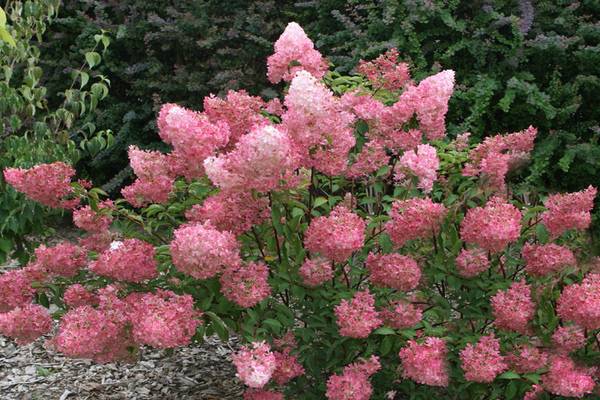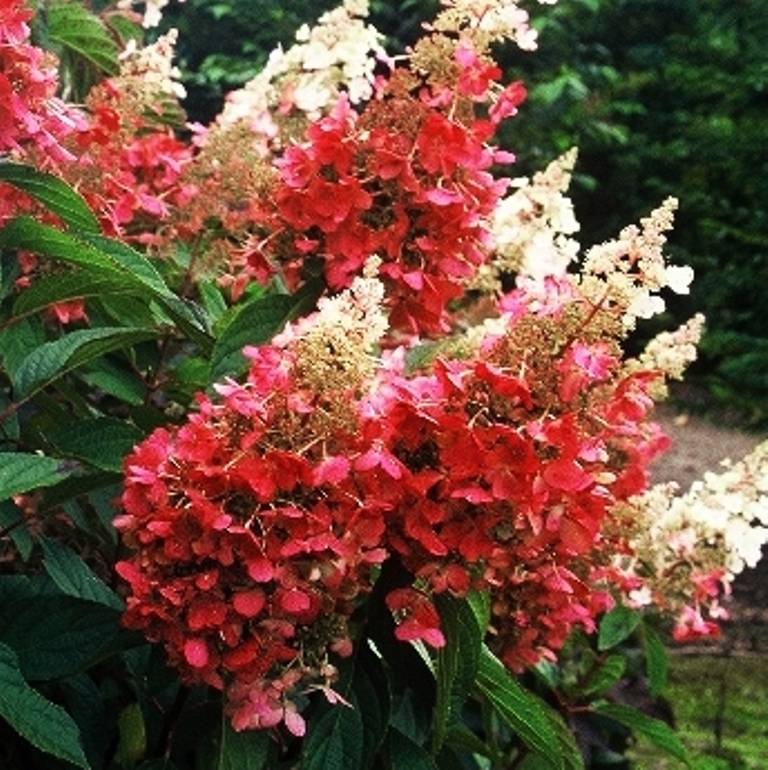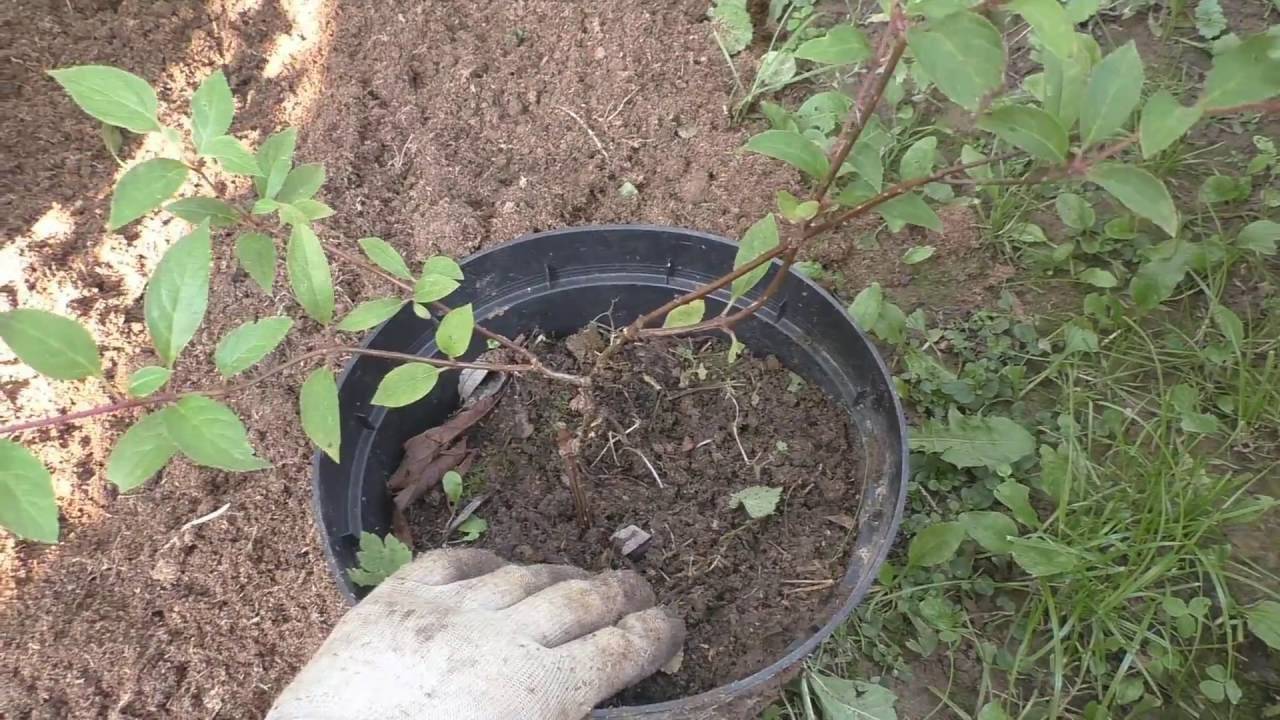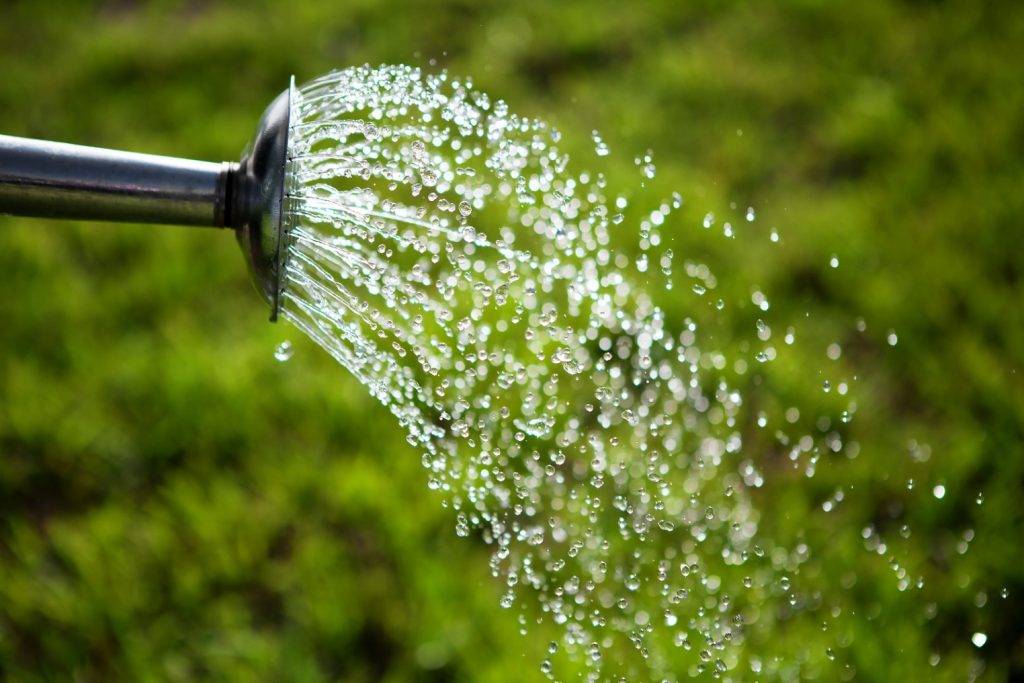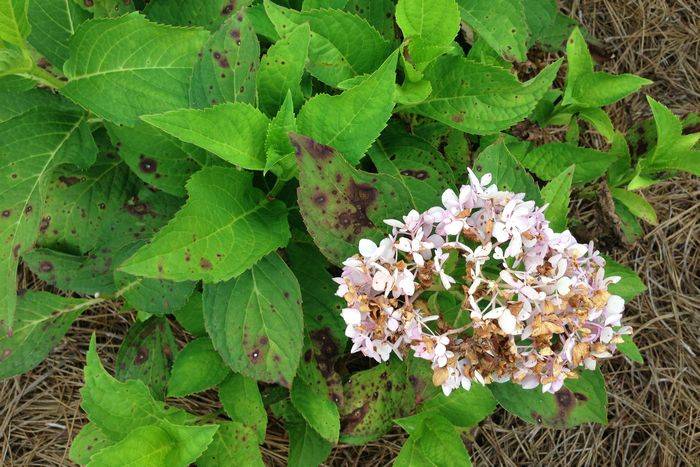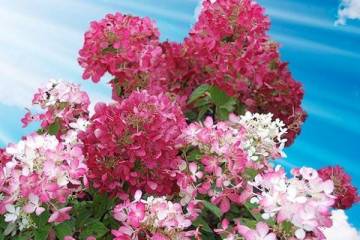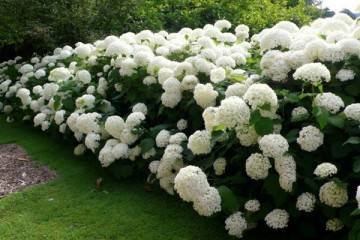Hydrangea Pink Lady - outdoor cultivation, variety description
Content:
Pink Lady is a Dutch variety of panicle hydrangea. This unpretentious plant will dilute even the most boring site design with bright colors. But only with proper care, the decorative qualities of the flower will reveal themselves in full force.
Appearance and description of Pink Lady hydrangea
Pink lady is a common variety of hydrangea (from Lat.Hydrangea Paniculata). A new panicle variety appeared in the Kingdom of England in the 20th century. And since then it has become a favorite among gardeners, which is not surprising. A tall two-meter bush with wide spreading branches in the form of a fan and voluminous flowers attracts the eye. A special look to the plant is given by the bright green flat leaves of hydrangea with small teeth at the edges. The inflorescences resemble a cone and consist of two varieties of small bisexual flowers up to 3 cm in diameter. Due to the compact arrangement of the inflorescences, the bush acquires a volumetric regular shape.
Hydrangea blooms from July until frost, revealing all the beauty of the color. With proper care, the bushes can please the owners for up to 10 years without a transplant.
Reproduction of panicle hydrangea
Pink lady is propagated in two ways:
- cuttings;
- layering.
The first planting option is carried out in the spring. For this, a shoot with four buds is cut off, placed in the ground and covered with a cap on top to create the effect of a greenhouse. Covering material is removed when the first shoots begin to break through on the handle.
When planting with young layers, shoots located closer to the ground are used. They are tilted to the ground, sprinkled with earth and left like that. Throughout the warm period, the root system grows and adapts to a new place.
Landing in open ground
Planting hydrangeas in open ground is possible in the spring, before the buds appear, or in the fall after leaf fall. The first landing option is the most acceptable. The main development of the root system and rooting occurs faster at positive temperatures. Spring planting promotes early flowering. Transplanting hydrangeas in the fall is more difficult. A fragile seedling requires shelter from low temperatures. As the experience of gardeners shows, in the second case, young bushes take root worse.
The choice of location should be taken seriously. Picky hydrangea Pink lady prefers sunny rooting places and does not like drafts. The flowers turn pale under the rays of the scorching sun. Ideal for planting on the south side, next to an object that creates a light shade, but not near trees, otherwise the roots will not receive the full amount of nutrients.
Hydrangea Pink Lady shows the best qualities when planted in neutral soil without the presence of alkali, better loam. Sandy terrain will also not work.
Two days before planting, the roots of the hydrangea are pruned and disinfected, treated with a growth stimulant with the addition of potassium permanganate. A hole is dug in advance. A day before planting, about 20 liters of water are poured there. When planting, it is important to spread the roots of the plant. You need to fill up the earth carefully, trying not to tamp it. After that, you need to water again. For group planting, the distance between the bushes is maintained at least 3 m.
Care of the Pink Lady variety
Hydrangea Pink lady does not require laborious maintenance. Shrubs are unpretentious. The difference will manifest itself only in the peculiarities of flowering. A well-groomed hydrangea, with proper watering and timely fertilization, blooms brighter, more luxuriantly and longer. Such inflorescences are much larger, and the bush itself looks well-formed and neat.
Watering
The paniculate species is hygrophilous. Drying out of the soil immediately affects the appearance. Every week, under the bush, you need to pour at least 30 liters of warm water in the summer in the heat and 10 liters in the cool time. This should be done in the morning or evening. Water is poured closer to the roots so that it does not fall on the leaves and flowers.
Top dressing
Nutrients should be added at least 4 times a year. It can be organic or mineral fertilizers. The first application occurs in the spring, when the buds have already formed, but have not yet blossomed. For organic feeding, one part of bird droppings or mullein is mixed with 15 parts of water.
The next time the dressing is added in the summer. During the formation of buds, 10 liters of water are poured under the bush with the addition of ammonium nitrate 35 g and superphosphate 20 g. In mid-July, the soil near Pink Lady is fertilized with granules for hydrangeas. The solution is prepared in a volume of 30 liters per bush. The proportions are indicated by each manufacturer on the package.
The fourth stage of fertilization is final. After the hydrangea has faded, potassium salt and superphosphate are poured under the plant, 50 g each. It is important that the composition of the fertilizer does not contain nitrogen.
Shrub pruning
The pruning procedure for this hydrangea variety is available even for a novice gardener. It is important to hold this event in the last days of March. The bush is examined and all weakened, diseased branches are removed. In an old plant, the new growth is shortened so that it rises no more than 6 cm above the soil. This will help the plant to renew itself faster.
Preparing for winter
When switching to winter time, the capricious Pink Lady is insulated: Dry flowers are removed, deciduous litter is raked to prevent diseases, and a crown is formed. All diseased and damaged branches are cut off. Healthy strong shoots are shortened to the required length. Watering the plants is gradually stopped. You do not need to fertilize hydrangea during the cold period.
The root system should winter warm. For these purposes, a mullein or dried leaves are suitable. In regions with cold winters, young seedlings are wrapped in burlap or special non-woven fabric. When the snow falls, you can fill the bush with them over the shelter, giving the hydrangea the shape of a snowdrift.
Diseases and pests
A common plant disease is powdery mildew. Its distinctive characteristic is a whitish bloom on the leaves of the bush. As a rule, all infections are activated during periods of increased moisture and cold. From special means for combating popular diseases, gardeners choose phytosporin, topaz or quadrix. Still, it is easier to prevent than to cure.
For the prevention of paniculate hydrangea diseases, it is important to weed between the bushes in a timely manner, to process Pink Lady with copper sulfate. From folk remedies, a decoction of onion peels is used.It is harmless and suitable for any season. Of the pests, the most dangerous is aphids. Get rid of it using trichopolum or aktofit. The difficulty is that all hydrangea leaves need to be treated with insecticides to avoid spreading the infection.
Hydrangea is a great option for creating hedges, decorating recreation areas. But it depends only on proper care how long its lush, enchanting flowering will last.
